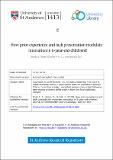Files in this item
Prior experience mediates the usage of food items as tools in great apes (Pan paniscus, Pan troglodytes, Gorilla gorilla, and Pongo abelii)
Item metadata
| dc.contributor.author | Ebel, Sonja J. | |
| dc.contributor.author | Völter, Christoph J. | |
| dc.contributor.author | Call, Josep | |
| dc.date.accessioned | 2021-04-19T16:30:02Z | |
| dc.date.available | 2021-04-19T16:30:02Z | |
| dc.date.issued | 2021-02-01 | |
| dc.identifier | 271535328 | |
| dc.identifier | d217fba2-09ee-4906-af9b-cafb9ce644fb | |
| dc.identifier | 85086854653 | |
| dc.identifier | 000618240600008 | |
| dc.identifier.citation | Ebel , S J , Völter , C J & Call , J 2021 , ' Prior experience mediates the usage of food items as tools in great apes ( Pan paniscus , Pan troglodytes , Gorilla gorilla , and Pongo abelii ) ' , Journal of Comparative Psychology , vol. 135 , no. 1 , pp. 64-73 . https://doi.org/10.1037/com0000236 | en |
| dc.identifier.issn | 0735-7036 | |
| dc.identifier.other | ORCID: /0000-0002-8597-8336/work/85168122 | |
| dc.identifier.uri | https://hdl.handle.net/10023/23056 | |
| dc.description.abstract | Humans use tools with specific functions to solve tasks more efficiently. However, functional specialization often comes at a cost: It can hinder the production of actions that are not usually performed with those tools, thus resulting in a fixation effect (functional fixedness). Little is known about whether our closest living relatives, the nonhuman great apes, are vulnerable to this detrimental effect of experience. We examined whether great apes from 4 species (N = 35) would become fixated on the familiar action with an object. More precisely, some subjects experienced a novel food item (grissini), either whole or broken into pieces, whereas others did not. Then, subjects faced a task that required them to use the food item to rake in an out-of-reach food reward. Results indicated that all 4 species could use a food item as a tool. Apes were more likely to do so in the first trial when they had not experienced the tool as food before, even though they tasted the food before using it as a tool. Orangutans and bonobos used the food item more often as a tool than chimpanzees. A preference test ruled out that performance was dependent on individual or species food preferences. Our results suggest that apes might have represented one object in two different ways (i.e., as "food" and as "tool") and then became fixated on one of these two representations. However, it is unclear whether the fixation occurred because of the item's prior function or its identity. | |
| dc.format.extent | 10 | |
| dc.format.extent | 1003414 | |
| dc.language.iso | eng | |
| dc.relation.ispartof | Journal of Comparative Psychology | en |
| dc.subject | Einstellung effect | en |
| dc.subject | Functional fixedness | en |
| dc.subject | Object identity | en |
| dc.subject | Self-control | en |
| dc.subject | Tool use | en |
| dc.subject | BF Psychology | en |
| dc.subject | Ecology, Evolution, Behavior and Systematics | en |
| dc.subject | Psychology (miscellaneous) | en |
| dc.subject | NDAS | en |
| dc.subject | MCC | en |
| dc.subject.lcc | BF | en |
| dc.title | Prior experience mediates the usage of food items as tools in great apes (Pan paniscus, Pan troglodytes, Gorilla gorilla, and Pongo abelii) | en |
| dc.type | Journal article | en |
| dc.contributor.institution | University of St Andrews. School of Psychology and Neuroscience | en |
| dc.contributor.institution | University of St Andrews. Centre for Social Learning & Cognitive Evolution | en |
| dc.identifier.doi | 10.1037/com0000236 | |
| dc.description.status | Peer reviewed | en |
| dc.identifier.url | https://doi.org/10.1037/com0000236.supp | en |
This item appears in the following Collection(s)
Items in the St Andrews Research Repository are protected by copyright, with all rights reserved, unless otherwise indicated.

